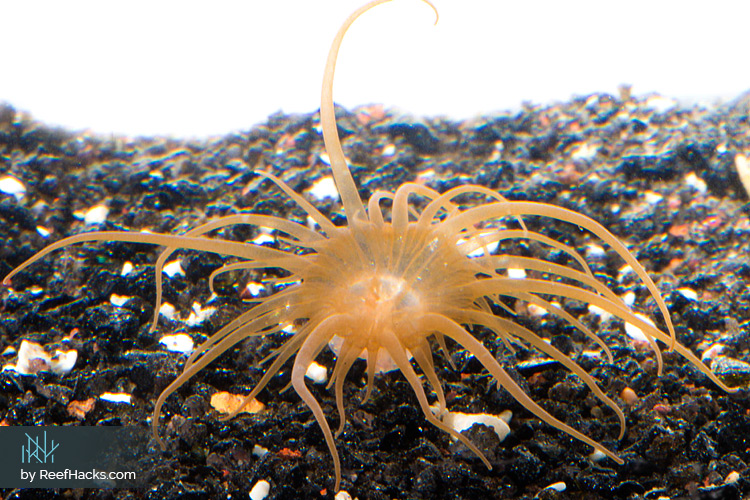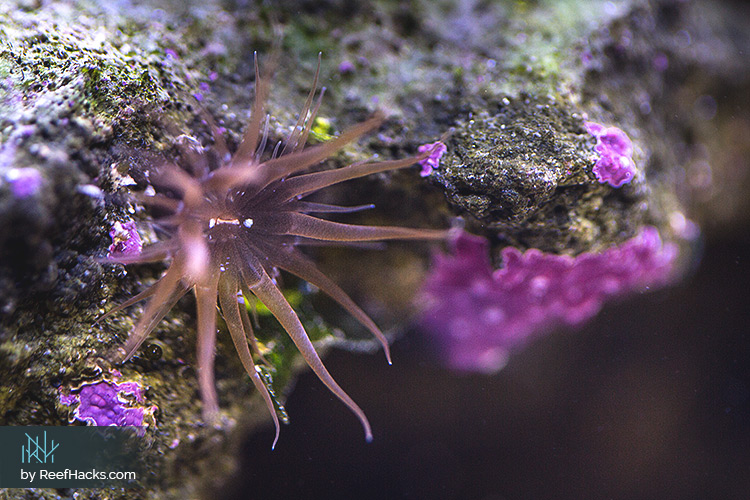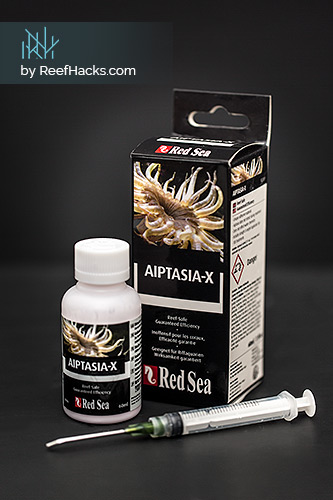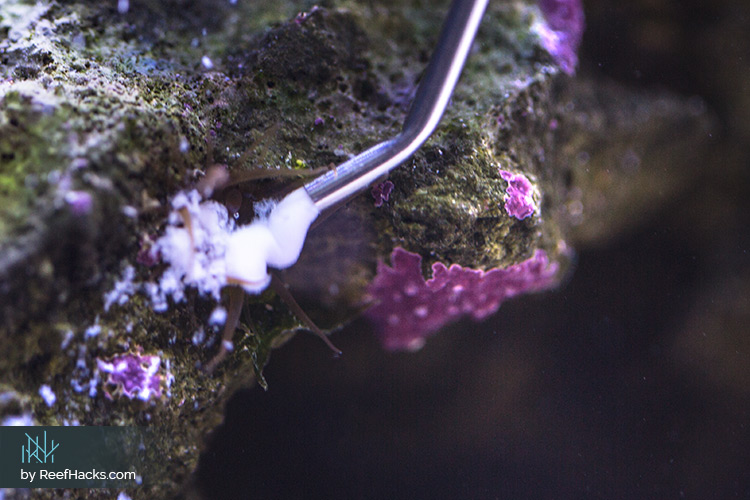Like a palm tree from hell, Aiptasia anemones attack even the most protected saltwater aquariums. Sooner or later, your journey into the underwater universe of reef tanks will put you face-to-face with the swaying tentacles of this aggressive anemone.
Okay, that may seem overly dramatic. However, if you’ve ever encountered the mesmerizing beauty of these harmful pests, you understand the need for dramatics. I’ve witnessed the damage of an Aiptasia outbreak in far too many tanks. Like a pervasive virus, these ancient organisms silently enter reef tanks and disrupt the delicate balance required to maintain a thriving ecosystem.
Whether you’re battling an army of Aiptasia in your current tank, or want to prepare for the inevitable invasion, let’s take a journey into the alien world of Aiptasia anemones.

Author:
As a lifelong aquarist, Yuliya has an endless curiosity about our underwater universe. After graduating with a bachelor’s in Environmental Engineering, she transformed her passion into a successful career. While working at the Institute of Environmental Protection in Moscow, her passion for saltwater and reef aquariums only increased. Moving to the United States in 2013, Yuliya embarked on another impactful journey by sharing her unprecedented experience for all aquarium hobbyists ... Read More.
The Sinister Side of Saltwater Tanks - Understanding Aiptasia Anemones.
Aquarists describe Aiptasia as creepy parasites to hauntingly beautiful organisms. I describe them as unwanted, demanding and deceptively attractive houseguests.
Imagine waking to the sound of an uninvited visitor rummaging through your kitchen. Eating your entire stash of potato chips, you ask this handsome guest how he got into your home. “Oh, I walked in with your new roommate,” he replies between bites. You look over and your roomie explains he didn’t know anyone was with him.
You want to kick your new roommate out for bringing in a pest, but you need him to pay your rent. So, instead, you try to get rid of the unwelcome hitchhiker. Nothing works. As soon as you push him out the door, he’s magically sitting on your couch finishing off the last bite of cake. It seems no matter what you do, this invasive houseguest appears invisible.
As crazy as this scenario seems, it’s exactly what dealing with an Aiptasia anemone is like. But why? To understand how this pest infiltrates your reef tank, the first step is understanding what it is.
Classified as a symbiotic cnidaria, Aiptasia is a common organism found in tropical seas. Unlike other creatures born out of the warm tropical oceans, Aiptasia can survive in a wide array of water quality conditions and water salinities. Its adaptable nature means it can thrive in a variety of saltwater tanks.
If you’ve ever witnessed an Aiptasia outbreak, then you’ve likely noted how quickly it propagates. This is due to its unique reproduction ability. While most invasive species reproduce sexually, Aiptasia multiplies both sexually and asexually. This means, even without a partner, this anemone spawns “children” from itself.
In fact, to create a new Aiptasia, only a single cell is needed. Have you ever wondered why your infestation never goes away? The answer is likely due to extermination methods. Microscopic damage, which sends off even a single cell into your tank is enough to repopulate the species.
Along with its naturally rapid reproduction, saltwater aquariums are perfect breeding grounds for Aiptasia. The carefully balanced reef tank water chemistry and ample light required to sustain life in your self-contained ecosystem is literally paradise for this pest.

Photography by Jack Koch. CC BY-SA 2.0
The Appearance of Invaders - What Aiptasia Look Like?
Also known as Glass, Tube or Rock anemones, Aiptasia’s aren’t difficult to identify. In essence, these pests look like underwater palm trees. The polyp body, which is the “trunk” of the anemone, attaches to a circular disk. Its waving branches are actually stinging tentacles.
Specific characteristics vary based on its species. For example, some Aiptasia species are clear while others feature earth tone coloration. The majority of saltwater aquarium Aiptasia’s are brownish-tan and range from barely noticeable to several inches long.
The Duality of Danger - Difference Between Aiptasia and Majano Anemone.
Identifying Aiptasia species isn’t difficult. Their small, stringy tentacles are a dead giveaway. However, this isn’t the only invasive anemone capable of invading your tank. The Majano anemone may appear similar, but its threat to your tank requires special attention.
Majano anemones are often larger and typically feature brightly colored designs. While they also have tentacles, they aren’t thin and stringy. Instead, its tentacles are club-shaped and are notoriously difficult to get rid of.
If you’re in doubt of the type of anemone in your tank, send us a picture and we’ll gladly help identify your uninvited guest.
No Good Deed Goes Unpunished - How Aiptasia Anemones Enter Your Tank.
Unless you’re one of the few quirky aquarists who appreciate invasive species, you certainly didn’t outright purchase an Aiptasia colony, or so you thought.
While you assumed the live rock or coral you carefully selected would bring balance and beauty to your saltwater aquarium, little did you know you were also bringing in a plague. Aiptasia anemones enter your tank by hitchhiking inside of live rocks or along the bottom of a frag plug of your new coral.
Unfortunately, these pests are excellent at hiding. When disturbed or threatened, they instantly retreat into the tiny holes located throughout a live rock. Masters of patience, Aiptasia colonies can remain inside their burrows for weeks or even months. By then, it’s too late. The rock or coral is happily living in your reef tank.
Why Evict Aiptasia Anemones From Your Tank?
The most common question asked about Aiptasia anemones is whether it kills fish and/or corals? In short, yes, but maybe not in the way you’d assume.
The biggest threat posed by Aiptasia is twofold. Its rapid reproduction often leads to overtaking the surface of rocks, which can make your tank as overcrowded as an NYC subway train during rush hour. However, the real harm comes down to its stinging tentacles. When threatened, venomous cells eject from its tentacles. The poison is capable of killing sensitive corals should they come too close to the Aiptasia’s turf.
What about fish? Is it possible for an Aiptasia to fatally harm the swimming inhabitants of your tank? While the damage from its sting isn’t powerful enough to kill larger fish or invertebrates, smaller creatures are no match for its territorial attack.
The Secret Life of an Aiptasia Assassin - Home Remedies of Death.
As you can see, the swaying branches of this underwater palm tree aren’t to be taken lightly. So, how do you kill an asexual organism capable of spawning new generations with a single cell? This answer has plagued countless aquarists since the dawn of saltwater aquariums.
The most notable issue with killing Aiptasia is doing so without compromising its physical integrity. As we’ve discussed, the smallest abrasion can release reproductive cells throughout your tank. Moreover, these masters of survival retreat into live rock holes at the first sign of danger.
Needless to say, you can’t simply reach in and grab them. However, aquarists have concocted numerous extermination methods designed to kill Aiptasia anemones in as little effort as possible. How, you may ask? By injecting a variety of substances found in your home directly into the anemone.
So, do these home remedies work? While some are more fiction than fact, there are several worth mentioning. These include:
For each method you should turn your flow OFF for 5 mins. before and during the treatment and wait 15 mins. before turning it back ON after the the treatment, including the return pump.
- Lemon Juice - Instead of reaching for your bottle of lemon juice to enhance your glass of water or cup of tea, maybe try it as an Aiptasia exterminator. While wearing gloves, fill a syringe with pure lemon juice and inject it directly into the Aiptasia. Make sure to move slowly to prevent scarring the anemone into its hole.
- Hydrogen Peroxide - Just like with the lemon juice, fill a syringe and carefully inject a small amount of the solution directly into the disk of the Aiptasia. Be extra careful to not release any hydrogen peroxide into the tank. Not the safest way.
- Kalkwasser - Also known as Calcium Hydroxide, kalkwasser is capable of killing Aiptasia. However, I don’t recommend this extermination tactic. In order to work, you must precisely fill the Aiptasia with a concentrated dose. If you try killing too many in this way, you can inadvertently raise your tank pH level, which is no good.
- Other Methods - Some of the other methods commonly used to eradicate Aiptasia include boiling water, vinegar, electricity and even super glue. If you’re considering these methods, there’s a better way that’s less dangerous to you, your tank and your bank account.
A Safer Alternative to Killing Aiptasia - Red Sea Aiptasia-X.
For those who know me, they understand I rarely promote extermination products. Why? Because most don’t work and actually put the rest of your tank inhabitants at risk. However, there are exceptions to every rule.
Red Sea Aiptasia-X is one of the best consumer extermination products available. After thoroughly investigating its application methodology and effectiveness, I was impressed at its accuracy. Formulated with a unique patented adhesive compound, Aiptasia-X prevents retraction during treatment and doesn’t negatively affect coral health.
I recommend this product when dealing with Aiptasia that’ve grown inside/around established coral colonies. In my experience, it’s the safest way to eradicate this pest without damaging sensitive sessile coral polyps.
Nature’s Calvary - What Fish Eat Aiptasia?
Of course, what guide would this be if we didn’t discuss the easiest way to control Aiptasia colonies? If you’re interested in eliminating this pest without using chemicals or introducing unnatural compounds into your tank, you may want to consider nature’s pest control team.
While introducing natural predators into your tank may seem like a good idea, there are several words of caution. Certain fish may choose to consume more than just Aiptasia anemones. Always proceed with caution when using predatory fish. However, if you’re interested in this extermination method, the following sea creatures are notoriously ravenous for Aiptasia:
- Peppermint Shrimp - Perhaps the most popular natural predator option, Peppermint Shrimp are an effective option if you purchase the right species. Make sure you use L. wurdemanni shrimp, as these little guys are crazy about Aiptasia anemones. But sometimes they can damage other soft corals in rare cases when hungry.
- Copperband Butterflyfishes - While effective killers, these beautiful fish may also find more non-pest inhabitants a delicious meal. These fish tend to consume sessile invertebrates, beneficial anemones, feather dusters and clams. Another word of caution, these fish take time to develop into Aiptasia killers and are notoriously difficult to keep alive in saltwater aquariums.
- Berghia Nudibranch - Classified as a sea slug, the Aiptasia eating nudi is a delightfully interesting creature who has a penchant for pest anemone. Officially known as Berghia verrucicornis, it is a natural predator of Aiptasia and is a safe addition to any reef tank. Unlike other natural predators, the Nudibranch isn’t interested in harming other tank inhabitants or coral. Plus, their shape and design adds a unique aesthetic. You know it’s having its fill on Aiptasia anemone as its gills turn a dark purplish hue as they eat. For optimum control, add four or five Nudibranch’s to your tank and let Mother Nature do her job. Where to buy them? This is my favorite place where I get mine: https://reeftown.com - Always quality and healthy Nudibranch from ReefTown.
- Aiptasia Eating Filefish - Also known as Acreichthys tomentosus, Aiptasia eating filefish come from Indonesia and are ravenous for pesky anemones. It should be noted that the Aiptasia Eating Filefish are shy fish with a tendency to be aggressive toward its own species and other small fish. While these hungry critters aren’t picky eaters, if their food stores dwindle, they’re known to nip on corals. Only introduce Aiptasia Eating Filefish in relatively large tanks. We don’t suggest using this fish in a tank smaller than 30 gallons.
- Hermit Crabs - In my opinion, hermit crabs are the safest predatory animal. Not only do they consume Aiptasia anemones, but they also have a taste for algae. But these are like peppermint shrimps, maybe they will never touch them at all. it's a lottery.
The Battle of Tank Survival - We’re Here for You.
Aiptasia anemones may be aesthetically interesting, but admire their swaying tentacles for too long, and you’ll soon regret it. While the extermination methods outlined in this guide can help eliminate an Aiptasia outbreak, sometimes a little extra help is needed.
Whether you’re a novice hobbyist, or an experienced aquarist, send us a message or comment below for help, advice or guidance. Battling this underwater invasion may be difficult, but together, we’ll transform your reef tank back to its healthy, happy and beautiful state.
by Yuliya Ivanova for ReefHacks.




